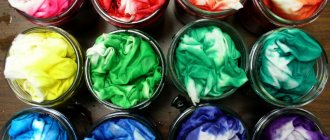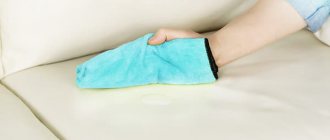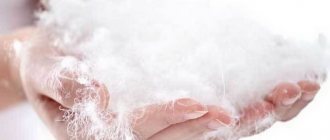Black jeans are a versatile, practical wardrobe item. They are suitable for men and women. Often, due to frequent washing and prolonged wear, the fabric fades and becomes faded. Then, instead of throwing it away, some housewives decide to paint their favorite thing and in this way give it a new life. Different dyes are used for coloring: natural or industrially produced.
Before staining
When deciding to radically update old jeans, you need to take into account all the subtleties of dyeing the fabric yourself. After all, the result of such a procedure does not always turn out as intended.
Much depends on the composition of the fabric itself. If it is made entirely of natural fibers, the color will change easily. When dyeing at home, the synthetic threads present often turn out to be slightly paler than the natural base.
The original color of the clothing makes its own adjustments. Contrasting fabric, when dyed black, sometimes turns out to have gray shades. If you need intense black, then you should choose jeans of a close, dark color.
Important! Before staining, carefully study the instructions and follow them exactly. Rubber gloves are worn to protect hands.
Preparation
Before you start changing the shade of old jeans, you prepare the item by performing a number of steps:
- Check clothes for grease stains and wash off all dirt. During the washing process, do not use balms or rinses, as they make subsequent dyeing difficult.
- Rip off all the labels so that they do not stain along with the main fabric. After the transformation is completed, they are sewn on again.
- To improve the result, it is better to bleach jeans of a radically different shade. Otherwise, you may end up with an ugly, strange color.
The workplace where the painting will be done is also prepared. The surface is covered with old oilcloth or newspapers, and excess items are removed.
Whitening
This procedure is done to improve the final result when the clothes initially differ in color from the desired shade. For bleaching, use regular “Whiteness” in liquid or powder form. The product is diluted in water according to the attached instructions and the solution is poured into a wide, deep basin.
How to choose a dye for black trousers?
Before you buy ondulin paint, pay attention to the composition of the material from which your trousers are made. The presence of synthetic threads such as lavsan or nitron makes painting ineffective, since they are practically impossible to dye. And subsequently, such actions can even ruin your trousers.
Paint for things has different purposes, a wide palette of colors, and different effects when applied.
If your trousers do not have a tag indicating the fiber composition, and you cannot determine the composition yourself, do not despair. In such cases, purchase a universal pants dye.
Important! To dye clothes, use only high-quality products; you can buy them in specialized stores. The result obtained will largely depend on this. For example, clothing paint from the Simplicol brand received many positive reviews.
Types of dyes
When dyeing denim, it is important to use dyes that are durable but at the same time safe. Industrial dyes purchased in the hardware department or in numerous craft supply stores in Moscow and other large cities are suitable for this. If it is not possible to purchase professional fabric paint, you can experiment with folk remedies.
Special dyes for fabric
The best result is obtained if you use special dyes for denim. They perfectly color dense fabric, do not give unexpected shades and do not spoil the fibers.
Aniline-based denim dye is commercially available in dense packaging, which describes in detail the entire process of DIY dyeing. In this case, you can get not only black trousers, but also other shades if you mix different tones of dye.
Important! It is advisable to buy dyes that are ready for use. They are applied to the fabric with a brush. Due to their good spreadability, such paints evenly saturate the material and do not form streaks.
Acrylic-based paints are very durable and dry quickly. The painted product can be safely washed in the usual way using washing powder or conditioner. Clothes will not fade or deteriorate. When dyeing, you can create patterns yourself by applying the dye to the fabric with a brush. To secure the design, the jeans are ironed from the inside out with a hot iron.
Powder dyes are very easy to use. They are easiest to use when dyeing jeans in the washing machine. The shade is uniform, but not too saturated. The procedure does not require significant effort, since it is performed automatically.
Spray paint is an effective way to decorate any fabric. In this case, you can use stencils or blanks to create a unique inscription or design on jeans. It is difficult to achieve uniform coloring using an aerosol can. But you can bring your creative ideas to life.
Dilon is intended for dyeing thick fabrics. On sale it is found in bulk containers. To dye jeans with Dillon, pour it into the washing machine into the powder compartment. Pre-washed and dried jeans are placed in a drum and the process is started by turning on any mode with hot water. After the end of the program, the product is washed again with regular washing powder, rinsed and dried. In this case, it is advisable to use a detergent with a minimum content of aggressive components.
Traditional methods
Such methods of changing the color of fabric were used back in Soviet times, when it was difficult to buy high-quality dyes. They often involve a complex coloring process and sometimes give unexpected and interesting results.
Using bleach
The easiest and most versatile way to get an unusual shade on dark and black jeans is to use bleach. It gives interesting stains on fabric:
- Fill a large metal bucket with water and pour 1 cup of bleach into it.
- Jeans are twisted in several places, tied in a knot or secured with tight elastic bands.
- The product is immersed in the solution, making sure that the fabric is completely covered with liquid.
- Heat the contents of the bucket over the fire for a quarter of an hour.
- Rinse the jeans in clean water, after removing the elastic bands and untying the knots, and dry them.
Hair dyeing
This is an unusual way to change the shade of jeans. A regular hair dye with a good composition is suitable for it. It is advisable to choose products that do not contain ammonia.
The staining process involves the following steps:
- Two packages of dye are diluted in a large amount of water. Developing milk and balm from the pack do not need to be added to the solution.
- Jeans are dipped into the well-mixed liquid and left for 2 hours.
- Periodically turn the product over in the solution and press it down so that the coloring proceeds evenly.
- Rinse the product in clean water.
- To fix the resulting color, place the item in a bowl of water, adding a little table vinegar and 1 tbsp. l. table salt. Keep jeans in this solution for 20 minutes.
Important! The result of dyeing with hair dye is unstable. Therefore, when washed, such a thing fades.
Staining with potassium permanganate
This color changing method is a little complicated, but when done accurately it produces an unusual shade of fabric. The process of changing the color of jeans is much simpler, since you do not need to boil the product. To dye things with potassium permanganate, perform the following steps:
- Combine 120 ml of table vinegar with a concentration of 9%, 30 ml of hydrogen peroxide 3% and 80 g of potassium permanganate.
- Add the resulting mass to a deep bowl of water.
- The jeans are twisted in several places with a tourniquet and secured with elastic bands.
- Dip the clothes into the solution until the liquid completely covers the fabric.
- Leave for 20 minutes.
- Rinse the clothes thoroughly in clean water, after removing the fastenings and straightening them.
- Wash twice in the washing machine with liquid detergent and dry naturally.
Painting with brilliant green
Among the folk dyes, some housewives use brilliant green to give an interesting emerald tint to black jeans. In this case, the sequence of actions will be as follows:
- In a large basin of water, dilute the brilliant green, adding the product until the desired shade is achieved.
- Dip clothes into the solution and leave for half an hour.
- Turn the product over regularly to ensure even coloring.
- Remove the pants from the solution and rinse thoroughly, changing the water several times. The last time, to fix the shade, add a little table vinegar to a bowl of water.
Select by fabric type
Depending on the composition, the painting features and the result change:
- Natural cotton, linen or semi-synthetic fabrics can be dyed well at home. The maximum amount of synthetic fibers in the material should not exceed 50%. The more synthetics, the lighter the finished shade;
- Synthetic fabrics are not dyed or dyed unevenly, with spots;
- Silk and viscose are dyed in cool water, gradually heating to almost boiling;
- Wool, leather, fur are suitable for painting.
There are several types of paints for dyeing and painting clothes on the market.
Simplicol
This is the name of German paints, characterized by a rich range of colors and high quality of color fixation in one step. Simplicol is intended for different materials:
- Natural fabrics in warm water;
- Silk, coarse types of wool, polyamide in hot water above 60⁰С;
- Underwear made of nylon, perlon (high temperatures produce rich colors, low temperatures produce delicate colors).
Universal paint "Tekhnokhim"
Dye made in Russia. Effective on linen, cotton, viscose, silk materials, as well as on fabrics with an unknown composition. The color is bright, juicy, and preserves well.
Dylon
They dye tulles, clothes made of silk, cotton, linen, and wool. Perfect for hand coloring, even without heating. Following the instructions, you will get a rich shade. To preserve it, the item is rinsed in a weak vinegar solution.
Dylon
Javana
Used for painting silk and synthetic items. Elegant decoration is done with a thin brush, and voluminous decor is done with a sponge or aerosol can. Fix the design with a hot iron, ironing it from the wrong side for 3 minutes.
JAVANA
Jacquard
Used for decorating textile materials. The acrylic composition is diluted with water, penetrates well into the fibers, colors evenly, and attracts with a variety of colors.
Selection rules
When choosing a dye for jeans, it is important to take into account the characteristics of the dye compositions. The most durable color is obtained after using acrylic dye. But such paints are quite expensive and you can’t buy them everywhere. The same disadvantage exists with aniline-based dyes. Their advantage is the richness of shades and ease of use.
Most folk methods are difficult to use and give unexpected results. In addition, their coloring is fragile. New jeans will fade a lot. The main advantage of such dyes is their low cost and availability.
Dyeing jeans in the washing machine
First, prepare the coloring composition, following the attached instructions. Dry matter is not placed in the washing powder compartment. For better solubility, the powder is first mixed with a small amount of water.
Important! To ensure uniform coloring, the formation of dense clots should not be allowed. Therefore, it is advisable to pass the dye mixed with water through cheesecloth several times.
The prepared dye is poured into the washing powder compartment. If required according to the instructions, add salt, a tint fixer or baking soda. The jeans, turned inside out and carefully straightened, are placed in the drum. To ensure a lasting result, set the machine to a temperature of 90 degrees and last for at least 1.5 hours.
While coloring is in progress, prepare a solution to fix the color. To do this, mix warm water with table vinegar, adding 1 tbsp for each liter. l. substances. When the program ends, the product is removed from the washing machine and immersed in a basin of vinegar water.
After this, the item is put back into the machine for washing and the mode is set at a temperature of +40 degrees. In this case, liquid detergent for colored items is used for washing. Repeated treatment will wash out the remaining dyes from the fabric and the washing machine mechanism.
After such painting, a small amount of colored solution remains in the drum of the unit. Therefore, to remove it, the machine is started in idle mode again. It is allowed to add citric acid to the washing powder compartment. It will clean the inside of the device from dirt and scale.
Why are black clothes washed with a special detergent?
Many housewives do not consider it shameful to wash dark clothes together with colored ones. After all, few people understand why to purchase a special product if a universal powder for multi-colored fabrics does the job well. We hasten to warn you that popular opinion is not always correct. There are several reasons that will help you understand why you should not neglect purchasing such a product:
- Powders leave unsightly white stains and undissolved grains on dark fabric.
- Over time, they wash out the rich pigment, and the item becomes faded and shabby.
- Increasingly, experts recommend using gels, since their compositions do not contain volatile substances that can cause allergies.
- Products marked “For Black” contain special, specially developed formulas that protect the color from fading and help preserve the fabric.
In addition to general tips and recommendations, there are several folk methods that will help you preserve the nobility of the dark:
- Add 120 g of table salt to the drum. It maintains color saturation and partially restores its former brightness.
- Before cleaning, soak things for half an hour in a vinegar solution (one tablespoon per liter of water). To get rid of odor, use conditioner when rinsing.
- If you have chlorinated water, then be sure that it helps wash out the dye, and add 120 g of soda during washing.
Important: manufacturers do not recommend cleaning black and white items yourself. It is better to entrust this process to dry cleaning.
To choose the right gel or powder for dark fabrics, let's first look at the range on offer.
Hand dyeing
Preparing paint using this method is no different from dyeing in a washing machine. The prepared product is poured into a large enamel pan with water and mixed thoroughly. Then the prepared jeans are immersed in it and placed on low heat.
The jeans are heated on the stove for 40-60 minutes. It is important not to allow the liquid to boil. All this time, make sure that the fabric is completely covered with water. Periodically turn the clothes over to obtain an even shade.
The painted product is thoroughly rinsed in clean water. Then prepare a solution in a basin by mixing water with vinegar at a concentration of 9%. Leave the dyed pants in this solution for 15 minutes and rinse again.
Necessary tool
To dye clothes at home you will need:
- dye;
- a simple pencil (if a design is planned on the fabric, its outline is drawn);
- brushes or syringes without needles;
- a piece of clean cloth;
- palette for mixing colors;
- cotton pads (sticks);
- containers for coloring (old pots, basins);
- water or other paint thinner.
The specific set of tools is determined by the nature of the pattern and the chosen coloring technology.
Simple pencils
Syringe without needle
Cotton pads
Caring for Hand-Dyed Jeans
Hand-painted items require special care. If washed or dried incorrectly, jeans fade, stains appear on them, and the shade changes. Then the clothes have to be thrown away.
To prevent damage to the product, observe the following rules:
- to prevent clothes from fading, dry them in a shaded place;
- in order not to spoil other things, dyed jeans are washed separately;
- to fix the shade, pour a little table vinegar into the rinsing water;
- To wash black jeans, use a special liquid or powder for colored fabrics.
Preparatory work
The preparatory stage involves soaking the clothing (the base to be dyed) in cold water for an hour. After soaking, the base is hand washed and rinsed. Dyeing is done on dry fabric, so the clothes must be thoroughly dried. The dried fabric is ironed with an iron set to medium temperature. If the clothes are made of thin fabric, you can stretch them on a wooden frame to dry. When hand painting, you need to place a slightly absorbent base (for example, cardboard, thick paper) or a non-absorbent base (a piece of film) under the fabric to be painted.
Soaking clothes in cold water











